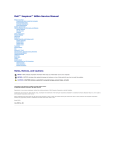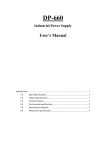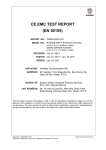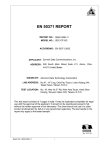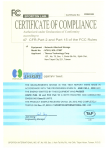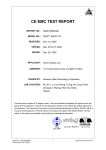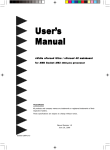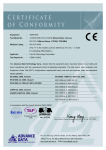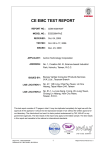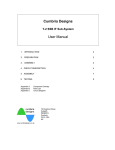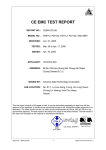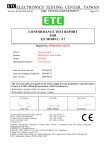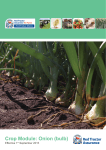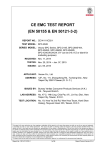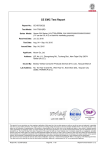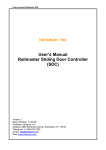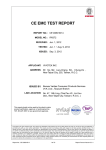Download RM941208L11 _SDC-CF10G 802.11g Compact Flash Module with
Transcript
EMC TEST REPORT REPORT NO. : RM941208L11 MODEL NO. : SDC-CF10G RECEIVED : Mar. 21, 2006 TESTED : Apr. 20 ~ Apr. 24, 2006 ISSUED : Apr. 27, 2006 APPLICANT: Summit Data Communications, Inc. ADDRESS: 526 South Main Street Suite 411, Akron, Ohio, 44311 United States ISSUED BY: Advance Data Technology Corporation LAB ADDRESS: No.47, 14th Ling, Chia Pau Tsuen, Linko Hsiang 244, Taipei Hsien, Taiwan, R.O.C. TEST LOCATION: No. 19, Hwa Ya 2nd Rd, Wen Hwa Tsuen, Kwei Shan Hsiang, Taoyuan Hsien 333, Taiwan, R.O.C. This test report consists of 32 pages in total. It may be duplicated completely for legal use with the approval of the applicant. It should not be reproduced except in full, without the written approval of our laboratory. The client should not use it to claim product endorsement by CNLA, A2LA or any government agency. The test results in the report only apply to the tested sample. Report No.: RM941208L11 1 Report Format Version 2.0.5 Table of Contents 1 2 3 3.1 3.2 3.3 3.4 4 4.1 4.1.1 4.1.2 4.1.3 4.1.4 4.1.5 4.1.6 4.1.7 5 5.1 5.2 5.3 5.4 5.4.1 5.4.2 5.4.3 5.4.4 5.4.5 5.4.6 5.5 5.5.1 5.5.2 5.5.3 5.5.4 5.5.5 5.5.6 6 7 CERTIFICATION ............................................................................................................... 3 SUMMARY OF TEST RESULTS........................................................................................ 4 GENERAL INFORMATION ................................................................................................ 5 GENERAL DESCRIPTION OF EUT................................................................................... 5 GENERAL DESCRIPTION OF APPLIED STANDARD ....................................................... 6 DESCRIPTION OF SUPPORT UNIT ................................................................................. 7 CONFIGURATION OF SYSTEM UNDER TEST................................................................. 7 EMISSION TEST ............................................................................................................... 8 CONDUCTED EMISSION MEASUREMENT...................................................................... 8 LIMITS OF CONDUCTED EMISSION MEASUREMENT.................................................... 8 TEST INSTRUMENTS....................................................................................................... 8 TEST PROCEDURE.......................................................................................................... 9 DEVIATION FROM TEST STANDARD .............................................................................. 9 TEST SETUP .................................................................................................................. 10 EUT OPERATING CONDITIONS..................................................................................... 10 TEST RESULTS .............................................................................................................. 11 IMMUNITY TEST............................................................................................................. 15 GENERAL DESCRIPTION .............................................................................................. 15 GENERAL PERFORMANCE CRITERIA DESCRIPTION.................................................. 15 EUT OPERATING CONDITION ....................................................................................... 16 ELECTROSTATIC DISCHARGE IMMUNITY TEST (ESD)................................................ 17 TEST SPECIFICATION ................................................................................................... 17 TEST INSTRUMENT ....................................................................................................... 17 TEST PROCEDURE........................................................................................................ 18 DEVIATION FROM TEST STANDARD ............................................................................ 18 TEST SETUP .................................................................................................................. 19 TEST RESULTS .............................................................................................................. 20 RADIATED, RADIO-FREQUENCY, ELECTROMAGNETIC FIELD IMMUNITY TEST (RS) 23 TEST SPECIFICATION ................................................................................................... 23 TEST INSTRUMENT ....................................................................................................... 23 TEST PROCEDURE........................................................................................................ 24 DEVIATION FROM TEST STANDARD ............................................................................ 24 TEST SETUP .................................................................................................................. 25 TEST RESULTS .............................................................................................................. 26 PHOTOGRAPHS OF THE TEST CONFIGURATION........................................................ 28 INFORMATION ON THE TESTING LABORATORIES ...................................................... 32 Report No.: RM941208L11 2 Report Format Version 2.0.5 1 CERTIFICATION PRODUCT: SDC-CF10G 802.11g Compact Flash Module with Antenna Connectors MODEL: SDC-CF10G BRAND: Summit TESTED: Apr. 20 ~ Apr. 24, 2006 APPLICANT: Summit Data Communications, Inc. TEST SAMPLE: ENGINEERING SAMPLE STANDARDS: EN 301 489-1 V1.5.1 (2004-11) EN 301 489-17 V1.2.1 (2002-08) EN 55022:1998+A1:2000+A2:2003, Class B EN 61000-4-2:1995+A1:1998+A2:2001 EN 61000-4-3:2002+A1:2002 The above equipment have been tested by Advance Data Technology Corporation, and found compliance with the requirement of the above standards. The test record, data evaluation & Equipment Under Test (EUT) configurations represented herein are true and accurate accounts of the measurements of the sample’s EMC characteristics under the conditions specified in this report. PREPARED BY : , DATE : Apr. 27, 2006 , DATE : Apr. 27, 2006 , DATE : Apr. 27, 2006 Jessie Wang TECHNICAL ACCEPTANCE : Responsible for EMC David Liu APPROVED BY : Clark Lin / Deputy Manager Report No.: RM941208L11 3 Report Format Version 2.0.5 2 SUMMARY OF TEST RESULTS After estimating all the combination of every test mode, the result shown as below is the worst case. The EUT has been tested according to the following specifications: EMISSION Standard Test Type EN 55022:1998+A1: 2000+A2:2003, Class B Result PASS Conducted Test Radiated Test NA Remarks Meets Class B Limit Minimum passing margin is -14.34dB at 4.309MHz Not Applicable NOTE: The information of measurement uncertainty is available upon the customer’s request. IMMUNITY (EN 301 489-1 V1.5.1, EN 301 489-17 V1.2.1) Standard Test Type Result EN 61000-4-2:1995 +A1:1998+A2:2001 Electrostatic discharge PASS immunity test Radiated, radio-frequency, EN 61000-4-3:2002 PASS electromagnetic field immunity +A1:2002 test NOTE: Please refer to Item 3.3 for more detailed description. Report No.: RM941208L11 4 Remarks Meets the requirements of Performance Criterion A Meets the requirements of Performance Criterion A Report Format Version 2.0.5 3 GENERAL INFORMATION 3.1 GENERAL DESCRIPTION OF EUT SDC-CF10G 802.11g Compact Flash Module with Antenna Connectors SDC-CF10G PRODUCT MODEL NO. 3.3Vdc from host equipment CCK, DQPSK, DBPSK for DSSS 64QAM, 16QAM, QPSK, BPSK for OFDM POWER SUPPLY MODULATION TYPE MODULATION TECHNOLOGY DSSS, OFDM NUMBER OF CHANNEL 802.11b:11/5.5/2/1Mbps 802.11g: 54/48/36/24/18/12/9/6Mbps 13 OPERATING FREQUENCY 2400 ~ 2483.5MHz ANTENNA TYPE Refer to Note 1 as below I/O PORTS NA DATA CABLE NA TRANSFER RATE NOTE: 1. There are 3 antennas provided to this EUT. The information about those antennas as below table: ANTENNA NO. MODEL NAME TYPE GAIN 1 2 3 VMT MX3 Dipole Dipole Printed 2.2dBi 2.2dBi 0dBi TYPE OF ANTENNA CONNECTOR UFL UFL UFL * After pre-test for each type of antenna and chosen the antenna 2 & 3 for test. 2. There are two test results presented in the report, please refer to list as below. Test Mode Test Condition A Antenna 2: Dipole antenna with 2.2dBi B Antenna 3: Printed antenna with 0dBi 3. The platform: (1) Mobile Data Terminals (MDTs), (2) Vehicle Mounted Devices(VMDs) 4. The EUT, operates in the 2.4GHz frequency range, lets you connect IEEE 802.11g or IEEE 802.11b devices to the network. With its high-speed data transmissions of up to 54Mbps. 5. The above EUT information was declared by the manufacturer and for more detailed features description, please refer to the manufacturer's specifications or User's Manual. Report No.: RM941208L11 5 Report Format Version 2.0.5 3.2 DESCRIPTION OF TEST MODE The EUT was tested under following conditions: CONDITION CONFIGURATION 1 Transmission 2 Standby There are two test results presented in the report, please refer to list as below. TEST MODE TEST CONDITION A Antenna 2: Dipole antenna with 2.2dBi B Antenna 3: Printed antenna with 0dBi 3.3 GENERAL DESCRIPTION OF APPLIED STANDARD The EUT is a RF product. According to the specifications of the manufacturer, it must comply with the requirements of the following standards: EN 301 489-1 V1.5.1 (2004-11), EN 301 489-17 V1.2.1 (2002-08) EN 55022:1998+A1:2000+A2:2003, Class B (Conducted Emission Test) EN 61000-4-2:1995+A1: 1998+A2:2001 EN 61000-4-3:2002+A1:2002 According to clause 7.1 (table 2) and clause 7.2 (table 3) of EN 301 489-1 V1.5.1 (2004-11), all test items have been performed and recorded as per the above standards. Report No.: RM941208L11 6 Report Format Version 2.0.5 3.4 DESCRIPTION OF SUPPORT UNIT The EUT has been tested as an independent unit together with other necessary accessories or support units. The following support units or accessories were used to form a representative test configuration during the tests. NO. 1 2 PRODUCT NOTEBOOK COMPUTER WIRELESS BROADBAND ROUTER NO. BRAND MODEL NO. SERIAL NO. FCC ID DELL PP05L 3616274224 E2K24CLNS BUFFALO WBR-G54 14070444314455 FCC DoC Approved SIGNAL CABLE DESCRIPTION OF THE ABOVE SUPPORT UNITS 1 NA 2 NA NOTE: 1. All power cords of the above support units are non shielded (1.8m). 2. Item 2 acted as communication partners to transfer data. 3.5 CONFIGURATION OF SYSTEM UNDER TEST Notebook EUT (Power from host equipment) Test Table Wireless Router *Kept in a remote area Report No.: RM941208L11 7 Report Format Version 2.0.5 4 EMISSION TEST 4.1 CONDUCTED EMISSION MEASUREMENT 4.1.1 LIMITS OF CONDUCTED EMISSION MEASUREMENT FREQUENCY (MHz) NOTE: Class A (dBuV) Class B (dBuV) Quasi-peak Average Quasi-peak Average 0.15 - 0.5 79 66 66 - 56 56 - 46 0.50 - 5.0 73 60 56 46 5.0 - 30.0 73 60 60 50 (1) The lower limit shall apply at the transition frequencies. (2) The limit decreases in line with the logarithm of the frequency in the range of 0.15 to 0.50 MHz. (3) All emanations from a class A/B digital device or system, including any network of conductors and apparatus connected thereto, shall not exceed the level of field strengths specified above. 4.1.2 TEST INSTRUMENTS DESCRIPTION & MANUFACTURER MODEL NO. SERIAL NO. CALIBRATED UNTIL Test Receiver ESCS30 100288 Nov. 02, 2006 ROHDE & SCHWARZ RF signal cable Cable-HYCO35D-FB Jan. 06, 2007 Woken 01 LISN ESH2-Z5 100100 Jan. 09, 2007 ROHDE & SCHWARZ LISN ESH3-Z5 100311 Jan. 22, 2007 ROHDE & SCHWARZ Software ADT_Cond_V3 NA NA ADT NOTE: 1. The calibration interval of the above test instruments is 12 months and the calibrations are traceable to NML/ROC and NIST/USA. 2. The test was performed in HwaYa Shielded Room 3. 3. The VCCI Site Registration No. is C-2047. Report No.: RM941208L11 8 Report Format Version 2.0.5 4.1.3 TEST PROCEDURE a. The EUT was placed 0.4 meters from the conducting wall of the shielded room with EUT being connected to the power mains through a line impedance stabilization network (LISN). Other support units were connected to the power mains through another LISN. The two LISNs provide 50 Ohm/ 50uH of coupling impedance for the measuring instrument. b. Both lines of the power mains connected to the EUT were checked for maximum conducted interference. c. The frequency range from 150 kHz to 30 MHz was searched. Emission levels under Limit - 20dB was not recorded. 4.1.4 DEVIATION FROM TEST STANDARD No deviation. Report No.: RM941208L11 9 Report Format Version 2.0.5 4.1.5 TEST SETUP V e r t ic a l G r o u n d R e f e r e n c e P la n e T e s t R e c e iv e r EUT 40cm 80cm L IS N H o r i z o n ta l G r o u n d R e fe re n c e P la n e N o t e : 1 .S u p p o r t u n i ts w e r e c o n n e c t e d t o s e c o n d L IS N . 2 .B o t h o f L IS N s ( A M N ) a r e 8 0 c m f r o m E U T a n d a t le a s t 8 0 c m f r o m o t h e r u n its a n d o t h e r m e t a l p l a n e s FOR THE ACTUAL TEST CONFIGURATION, PLEASE REFER TO THE RELATED ITEM – PHOTOGRAPHS OF THE TEST CONFIGURATION. 4.1.6 EUT OPERATING CONDITIONS a. Plugged EUT in notebook system and placed on the testing table. b. Prepared the wireless broadband router and placed it outside of testing area to act as communication partner for EUT. c. The communication partner sent data to EUT by command "PING". Report No.: RM941208L11 10 Report Format Version 2.0.5 4.1.7 TEST RESULTS INPUT POWER (SYSTEM) ENVIRONMENTAL CONDITIONS 230Vac, 50 Hz 6dB BANDWIDTH 9 kHz 25deg. C, 60% RH, 991hPa PHASE Line 1 TEST MODE A TESTED BY Kent Chen Freq. Corr. Reading Value [MHz] 0.173 0.291 2.098 4.309 11.941 13.625 Factor (dB) 0.10 0.10 0.21 0.37 0.46 0.56 [dB (uV)] Q.P. AV. 48.79 41.35 38.95 41.29 32.77 34.35 - No 1 2 3 4 5 6 Emission Level [dB (uV)] Q.P. AV. 48.89 41.45 39.16 41.66 33.23 34.91 - Limit Margin [dB (uV)] Q.P. AV. 64.79 54.79 60.51 50.51 56.00 46.00 56.00 46.00 60.00 50.00 60.00 50.00 (dB) Q.P. -15.90 -19.06 -16.84 -14.34 -26.77 -25.09 AV. - REMARKS: 1. Q.P. and AV. are abbreviations of quasi-peak and average individually. 2. "-": The Quasi-peak reading value also meets average limit and measurement with the average detector is unnecessary. 3. The emission levels of other frequencies were very low against the limit. 4. Margin value = Emission level - Limit value 5. Correction factor = Insertion loss + Cable loss 6. Emission Level = Correction Factor + Reading Value. Report No.: RM941208L11 11 Report Format Version 2.0.5 INPUT POWER (SYSTEM) ENVIRONMENTAL CONDITIONS 230Vac, 50 Hz 6dB BANDWIDTH 9 kHz 25deg. C, 60% RH, 991hPa PHASE Line 2 TEST MODE A TESTED BY Kent Chen Freq. Corr. Reading Value [MHz] 0.154 0.287 1.629 3.547 4.246 11.520 Factor (dB) 0.10 0.10 0.20 0.33 0.37 0.51 [dB (uV)] Q.P. AV. 43.02 39.17 38.49 38.47 40.44 39.66 - No 1 2 3 4 5 6 Emission Level [dB (uV)] Q.P. AV. 43.12 39.27 38.69 38.80 40.81 40.17 - Limit Margin [dB (uV)] Q.P. AV. 65.79 55.79 60.62 50.62 56.00 46.00 56.00 46.00 56.00 46.00 60.00 50.00 (dB) Q.P. -22.67 -21.35 -17.31 -17.20 -15.19 -19.83 AV. - REMARKS: 1. Q.P. and AV. are abbreviations of quasi-peak and average individually. 2. "-": The Quasi-peak reading value also meets average limit and measurement with the average detector is unnecessary. 3. The emission levels of other frequencies were very low against the limit. 4. Margin value = Emission level - Limit value 5. Correction factor = Insertion loss + Cable loss 6. Emission Level = Correction Factor + Reading Value. Report No.: RM941208L11 12 Report Format Version 2.0.5 INPUT POWER (SYSTEM) ENVIRONMENTAL CONDITIONS 230Vac, 50 Hz 6dB BANDWIDTH 9 kHz 25deg. C, 60% RH, 991hPa PHASE Line 1 TEST MODE B TESTED BY Kent Chen Freq. Corr. Reading Value [MHz] 0.170 0.236 0.349 1.629 3.719 11.449 Factor (dB) 0.10 0.10 0.10 0.16 0.35 0.44 [dB (uV)] Q.P. AV. 44.72 40.35 36.42 38.33 40.44 40.23 - No 1 2 3 4 5 6 Emission Level [dB (uV)] Q.P. AV. 44.82 40.45 36.52 38.49 40.79 40.67 - Limit Margin [dB (uV)] Q.P. AV. 64.98 54.98 62.24 52.24 58.98 48.98 56.00 46.00 56.00 46.00 60.00 50.00 (dB) Q.P. -20.16 -21.79 -22.46 -17.51 -15.21 -19.33 AV. - REMARKS: 1. Q.P. and AV. are abbreviations of quasi-peak and average individually. 2. "-": The Quasi-peak reading value also meets average limit and measurement with the average detector is unnecessary. 3. The emission levels of other frequencies were very low against the limit. 4. Margin value = Emission level - Limit value 5. Correction factor = Insertion loss + Cable loss 6. Emission Level = Correction Factor + Reading Value. Report No.: RM941208L11 13 Report Format Version 2.0.5 INPUT POWER (SYSTEM) ENVIRONMENTAL CONDITIONS 230Vac, 50 Hz 6dB BANDWIDTH 9 kHz 25deg. C, 60% RH, 991hPa PHASE Line 2 TEST MODE B TESTED BY Kent Chen Freq. Corr. Reading Value [MHz] 0.177 0.291 2.094 3.664 4.535 11.922 13.375 Factor (dB) 0.10 0.10 0.21 0.34 0.38 0.53 0.57 [dB (uV)] Q.P. AV. 47.07 41.47 39.76 39.00 37.70 39.47 40.24 - No 1 2 3 4 5 6 7 Emission Level [dB (uV)] Q.P. AV. 47.17 41.57 39.97 39.34 38.08 40.00 40.81 - Limit Margin [dB (uV)] Q.P. AV. 64.61 54.61 60.51 50.51 56.00 46.00 56.00 46.00 56.00 46.00 60.00 50.00 60.00 50.00 (dB) Q.P. -17.44 -18.94 -16.03 -16.66 -17.92 -20.00 -19.19 AV. - REMARKS: 1. Q.P. and AV. are abbreviations of quasi-peak and average individually. 2. "-": The Quasi-peak reading value also meets average limit and measurement with the average detector is unnecessary. 3. The emission levels of other frequencies were very low against the limit. 4. Margin value = Emission level - Limit value 5. Correction factor = Insertion loss + Cable loss 6. Emission Level = Correction Factor + Reading Value. Report No.: RM941208L11 14 Report Format Version 2.0.5 5 IMMUNITY TEST 5.1 GENERAL DESCRIPTION Product Standard EN 301 489-1 V1.5.1 (2004-11), EN 301 489-17 V1.2.1(2002-08) EN 61000-4-2 Basic Standard, Specification, and Performance Criterion required EN 61000-4-3 Electrostatic Discharge – ESD: 8kV air discharge, 4kV Contact discharge, Performance Criterion B Radio-Frequency Electromagnetic Field Susceptibility Test – RS: 80 ~ 1000 MHz, 1400 ~ 2000 MHz, 3V/m, 80% AM (1kHz), Performance Criterion A 5.2 GENERAL PERFORMANCE CRITERIA DESCRIPTION The Requirement of Performance Criteria 1 Performance criteria for continuous Criterion A of the applicable class shall apply phenomena applied to transmitters (CT) 2 Performance criteria for transient Criterion B of the applicable class shall apply phenomena applied to transmitters (TT) 3 Performance criteria for continuous Criterion A of the applicable class shall apply phenomena applied to receivers (CR) 4 Performance criteria for transient phenomena applied to receivers (TR) Report No.: RM941208L11 Criterion B of the applicable class shall apply 15 Report Format Version 2.0.5 The phenomena allowed during and after test in each criterion are clearly stated in the following table. Performance criteria Criteria A B During test After test Shall operate as intended. May show degradation of performance (see note1). Shall be no loss of function. Shall be no unintentional transmissions. Shall operate as intended. Shall be no degradation of performance (see note 2). Shall be no loss of function. Shall be no loss of stored data or user programmable functions. May show loss of function (one or more). May show degradation of performance (see note 1). No unintentional transmissions. Functions shall be self-recoverable. Shall operate as intended after recovering. Shall be no degradation of performance (see note 2). Shall be no loss of stored data or user programmable functions. May be loss of function (one or more). Functions shall be recoverable by the operator. Shall operate as intended after recovering. Shall be no degradation of performance (see note 2). C NOTE 1:Degradation of performance during the test is understood as a degradation to a level not below a minimum performance level specified by the manufacturer for the use of the apparatus as intended. In some cases the specified minimum performance level may be replaced by a permissible degradation of performance. If the minimum performance level or the permissible performance degradation is not specified by the manufacturer then either of these may be derived from the product description and documentation (including leaflets and advertising) and what the user may reasonably expect from the apparatus if used as intended. NOTE 2: No degradation of performance after the test is understood as no degradation below a minimum performance level specified by the manufacturer for the use of the apparatus as intended. In some cases the specified minimum performance level may be replaced by a permissible degradation of performance. After the test no change of actual operating data or user retrievable data is allowed. If the minimum performance level or the permissible performance degradation is not specified by the manufacturer then either of these may be derived from the product description and documentation (including leaflets and advertising) and what the user may reasonably expect form the apparatus if used as intended. 5.3 EUT OPERATING CONDITION Same as 4.1.6 Report No.: RM941208L11 16 Report Format Version 2.0.5 5.4 ELECTROSTATIC DISCHARGE IMMUNITY TEST (ESD) 5.4.1 TEST SPECIFICATION Basic Standard: EN 61000-4-2 Discharge Impedance: 330 ohm / 150 pF Discharge Voltage: Air Discharge : 2; 4; 8 kV (Direct) Contact Discharge : 2; 4 kV (Direct/Indirect) Polarity: Positive & Negative Number of Discharge: Minimum 20 times at each test point Discharge Mode: Single Discharge Discharge Period: 1 second minimum 5.4.2 TEST INSTRUMENT DESCRIPTION & MANUFACTURER MODEL NO. SERIAL NO. CALIBRATED UNTIL Thermo ESD Simulator MZ-15/EC 0310225 Sep. 29, 2006 ELECTROSTATIC DISCHARGE ESD 30C 1003-12 Jul. 10, 2006 ESS-2000 ESS0382041 Jan. 10, 2007 NOISEKEN ELECTRONIC DISCHARGE SIMULATOR NOTE: 1. The test was performed in Hwa Ya ESD Room No. 2. 2. The calibration interval of the above test instruments is 12 months and the calibrations are traceable to NML/ROC and NIST/USA. Report No.: RM941208L11 17 Report Format Version 2.0.5 5.4.3 TEST PROCEDURE a. Electrostatic discharges were applied only to those points and surfaces of the EUT that are accessible to users during normal operation. b. The test was performed with at least ten single discharges on the pre-selected points in the most sensitive polarity. c. The time interval between two successive single discharges was at least 1 second. d. The ESD generator was held perpendicularly to the surface to which the discharge was applied and the return cable was at least 0.2 meters from the EUT. e. Contact discharges were applied to the non-insulating coating, with the pointed tip of the generator penetrating the coating and contacting the conducting substrate. f. Air discharges were applied with the round discharge tip of the discharge electrode approaching the EUT as fast as possible (without causing mechanical damage) to touch the EUT. After each discharge, the ESD generator was removed from the EUT and re-triggered for a new single discharge. The test was repeated until all discharges were complete. g. At least ten single discharges (in the most sensitive polarity) were applied to the Horizontal Coupling Plane at points on each side of the EUT. The ESD generator was positioned vertically at a distance of 0.1 meters from the EUT with the discharge electrode touching the HCP. h. At least ten single discharges (in the most sensitive polarity) were applied to the center of one vertical edge of the Vertical Coupling Plane in sufficiently different positions that the four faces of the EUT were completely illuminated. The VCP (dimensions 0.5m x 0.5m) was placed vertically to and 0.1 meters from the EUT. 5.4.4 DEVIATION FROM TEST STANDARD No deviation. Report No.: RM941208L11 18 Report Format Version 2.0.5 5.4.5 TEST SETUP 0.1m 1m Vertical coupling plane 0.5mm Isolation Support ESD Generator EUT 470k X4 Nearest Wall PS 80cm Horizontal coupling plane Ground Reference Plane For the actual test configuration, please refer to the related item – Photographs of the Test Configuration. NOTE: TABLE-TOP EQUIPMENT The configuration consisted of a wooden table 0.8 meters high standing on the Ground Reference Plane. The GRP consisted of a sheet of aluminum at least 0.25mm thick, and 2.5 meters square connected to the protective grounding system. A Horizontal Coupling Plane (1.6m x 0.8m) was placed on the table and attached to the GRP by means of a cable with 940kW total impedance. The equipment under test, was installed in a representative system as described in section 7 of EN 61000-4-2 and its cables were placed on the HCP and isolated by an insulating support of 0.5mm thickness. A distance of 1-meter minimum was provided between the EUT and the walls of the laboratory and any other metallic structure. Report No.: RM941208L11 19 Report Format Version 2.0.5 5.4.6 TEST RESULTS ENVIRONMENTAL CONDITIONS 22 deg.C, 43% RH, 994 hPa INPUT POWER (SYSTEM) 230Vac, 50 Hz TEST MODE A TESTED BY Kent Chen TEST RESULTS OF DIRECT APPLICATION Discharge Level (kV) Polarity Test Point Contact Discharge Air Discharge Test Result 2;4;8 +/- 1 NA NOTE PASS Description of test point: Please refers to following pages for representative mark only. TEST RESULTS OF INDIRECT APPLICATION Discharge Level (kV) Polarity Test Point Horizontal Coupling Plane Vertical Coupling Plane Test Result 2; 4 +/- 4 sides NOTE NOTE PASS Description of test point: 2. Rear side 1. Front side 3. Right side 4. Left side NOTE: There was no change compared with initial operation during and after the test. No unintentional response was found during the test. Report No.: RM941208L11 20 Report Format Version 2.0.5 1 Report No.: RM941208L11 21 Report Format Version 2.0.5 ENVIRONMENTAL CONDITIONS 22 deg.C, 43% RH, 994 hPa INPUT POWER (SYSTEM) 230Vac, 50 Hz TEST MODE B TESTED BY Kent Chen TEST RESULTS OF INDIRECT APPLICATION Discharge Level (kV) Polarity Test Point Horizontal Coupling Plane Vertical Coupling Plane Test Result 2; 4 +/- 4 sides NOTE NOTE PASS Description of test point: 2. Rear side 1. Front side 3. Right side 4. Left side NOTE: There was no change compared with initial operation during and after the test. No unintentional response was found during the test. Report No.: RM941208L11 22 Report Format Version 2.0.5 5.5 RADIATED, RADIO-FREQUENCY, ELECTROMAGNETIC FIELD IMMUNITY TEST (RS) 5.5.1 TEST SPECIFICATION Basic Standard: Frequency Range: EN 61000-4-3 80 MHz ~ 1000 MHz 1400 MHz ~ 2000 MHz Field Strength: 3 V/m Modulation: 1 kHz Sine Wave, 80%, AM Modulation Frequency Step: 1 % of preceding frequency value Polarity of Antenna: Horizontal and Vertical Test Distance: 3m Antenna Height: 1.5 m Dwell Time: at least 3 seconds 5.5.2 TEST INSTRUMENT DESCRIPTION & MANUFACTURER MODEL NO. Boonton RF Power Meter 4232A-01-02 107402 Nov. 20, 2006 SML03 101499 Nov. 20, 2006 FP 6001 307198 Mar. 19, 2007 ADT_RS_V450 NA NA R&S Signal Generator AR ELECTRIC FIELD SENSOR Software SERIAL NO. CALIBRATED UNTIL NOTE: 1. The test was performed in Hwa Ya RS Room. 2. The calibration interval of the above test instruments is 12 months and the calibrations are traceable to NML/ROC and NIST/USA. Report No.: RM941208L11 23 Report Format Version 2.0.5 5.5.3 TEST PROCEDURE The test procedure was in accordance with EN 61000-4-3 a. The testing was performed in a fully-anechoic chamber. The transmit antenna was located at a distance of 3 meters from the EUT. b. The frequency range is swept from 80 MHz to 1000 MHz, 1400 MHz to 2000 MHz with the signal 80% amplitude modulated with a 1kHz sinewave. The rate of sweep did not exceed 1.5 x 10 -3 decade/s. Where the frequency range is swept incrementally, the step size was 1 % of preceding frequency value. c. The dwell time at each frequency shall be not less than the time necessary for the EUT to be able to respond. d. The field strength level was 3V/m. e. The test was performed with the EUT exposed to both vertically and horizontally polarized fields on each of the four sides. 5.5.4 DEVIATION FROM TEST STANDARD No deviation. Report No.: RM941208L11 24 Report Format Version 2.0.5 5.5.5 TEST SETUP 3m measurement distance in a Full Anechoic Chamber EUT RF Amplifier RF Generator and control system Monitoring system For the actual test configuration, please refer to the related item – Photographs of the Test Configuration. NOTE: TABLETOP EQUIPMENT The EUT installed in a representative system as described in section 7 of EN 61000-4-3 was placed on a non-conductive table 0.8 meters in height. The system under test was connected to the power and signal wire according to relevant installation instructions. Report No.: RM941208L11 25 Report Format Version 2.0.5 5.5.6 TEST RESULTS ENVIRONMENTAL CONDITIONS 25 deg. C, 52% RH, 994 hPa INPUT POWER (SYSTEM) 230Vac, 50 Hz TEST MODE A TESTED BY Kent Chen Field Frequency (MHz) Polarity Azimuth Strength (V/m) Observation Test Result 80 ~ 1000 V&H 0 3 NOTE PASS 80 ~ 1000 V&H 90 3 NOTE PASS 80 ~ 1000 V&H 180 3 NOTE PASS 80 ~ 1000 V&H 270 3 NOTE PASS 1400 ~ 2000 V&H 0 3 NOTE PASS 1400 ~ 2000 V&H 90 3 NOTE PASS 1400 ~ 2000 V&H 180 3 NOTE PASS 1400 ~ 2000 V&H 270 3 NOTE PASS NOTE: There was no change compared with the initial operation during the test. No unintentional response was found during the test. Report No.: RM941208L11 26 Report Format Version 2.0.5 ENVIRONMENTAL CONDITIONS 25 deg. C, 52% RH, 994 hPa INPUT POWER (SYSTEM) 230Vac, 50 Hz TEST MODE B TESTED BY Kent Chen Azimuth Field Strength (V/m) Observation Test Result V&H 0 3 NOTE PASS 80 ~ 1000 V&H 90 3 NOTE PASS 80 ~ 1000 V&H 180 3 NOTE PASS 80 ~ 1000 V&H 270 3 NOTE PASS 1400 ~ 2000 V&H 0 3 NOTE PASS 1400 ~ 2000 V&H 90 3 NOTE PASS 1400 ~ 2000 V&H 180 3 NOTE PASS 1400 ~ 2000 V&H 270 3 NOTE PASS Frequency (MHz) Polarity 80 ~ 1000 NOTE: There was no change compared with the initial operation during the test. No unintentional response was found during the test. Report No.: RM941208L11 27 Report Format Version 2.0.5 6 PHOTOGRAPHS OF THE TEST CONFIGURATION Conducted Emission Test Test Mode A Report No.: RM941208L11 28 Report Format Version 2.0.5 Test Mode B Report No.: RM941208L11 29 Report Format Version 2.0.5 ESD Test Test Mode A Test Mode B Report No.: RM941208L11 30 Report Format Version 2.0.5 RS Test Test Mode A Test Mode B Report No.: RM941208L11 31 Report Format Version 2.0.5 7 INFORMATION ON THE TESTING LABORATORIES We, ADT Corp., were founded in 1988 to provide our best service in EMC, Radio, Telecom and Safety consultation. Our laboratories are accredited and approved by the following approval agencies according to ISO/IEC 17025: USA Germany Japan Norway Canada R.O.C. Netherlands Singapore Russia FCC, UL, A2LA TUV Rheinland VCCI NEMKO INDUSTRY CANADA , CSA CNLA, BSMI, DGT Telefication PSB , GOST-ASIA(MOU) CERTIS(MOU) Copies of accreditation certificates of our laboratories obtained from approval agencies can be downloaded from our web site: www.adt.com.tw/index.5/phtml. If you have any comments, please feel free to contact us at the following: Linko EMC/RF Lab Tel: 886-2-26052180 Fax: 886-2-26052943 Hsin Chu EMC/RF Lab Tel: 886-3-5935343 Fax: 886-3-5935342 Hwa Ya EMC/RF/Safety/Telecom Lab Tel: 886-3-3183232 Fax: 886-3-3185050 Linko RF Lab Tel: 886-3-3270910 Fax: 886-3-3270892 Web Site: www.adt.com.tw The address and road map of all our labs can be found in our web site also. Report No.: RM941208L11 32 Report Format Version 2.0.5

































